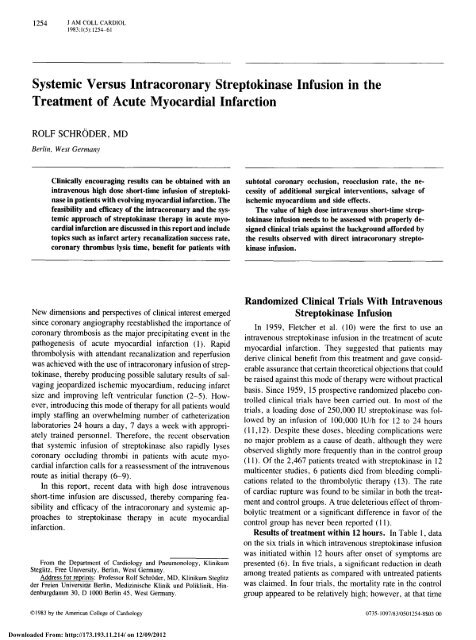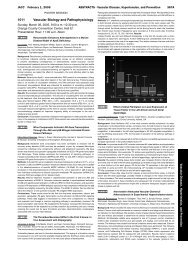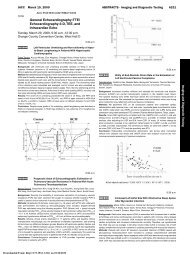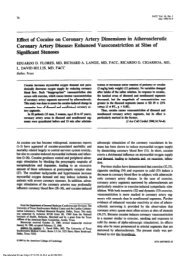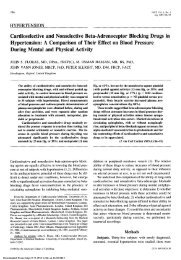Systemic versus intracoronary streptokinase infusion in the ...
Systemic versus intracoronary streptokinase infusion in the ...
Systemic versus intracoronary streptokinase infusion in the ...
You also want an ePaper? Increase the reach of your titles
YUMPU automatically turns print PDFs into web optimized ePapers that Google loves.
1254 J AM COLLCARDIOL<br />
1983: I(5):1254-61<br />
<strong>Systemic</strong> Versus Intracoronary Streptok<strong>in</strong>ase Infusion <strong>in</strong> <strong>the</strong><br />
Treatment of Acute Myocardial Infarction<br />
ROLF SCHRODER, MD<br />
Berl<strong>in</strong>. West Germany<br />
Cl<strong>in</strong>ically encourag<strong>in</strong>g results can be obta<strong>in</strong>ed with an<br />
<strong>in</strong>travenous high dose short-time <strong><strong>in</strong>fusion</strong> of <strong>streptok<strong>in</strong>ase</strong><br />
<strong>in</strong> patients with evolv<strong>in</strong>gmyocardial <strong>in</strong>farction. The<br />
feasibility and efficacy of <strong>the</strong> <strong><strong>in</strong>tracoronary</strong> and <strong>the</strong> systemic<br />
approach of <strong>streptok<strong>in</strong>ase</strong> <strong>the</strong>rapy <strong>in</strong> acute myocardial<br />
<strong>in</strong>farction are discussed <strong>in</strong> this report and <strong>in</strong>clude<br />
topics such as <strong>in</strong>farct artery recanalization success rate,<br />
coronary thrombus lysis time, benefit for patients with<br />
New dimensions and perspectives of cl<strong>in</strong>ical <strong>in</strong>terest emerged<br />
s<strong>in</strong>ce coronary angiography reestabli shed <strong>the</strong> importance of<br />
coronary thrombosis as <strong>the</strong> major precipitat<strong>in</strong>g event <strong>in</strong> <strong>the</strong><br />
pathogenesis of acute myocardial <strong>in</strong>farction (I). Rapid<br />
thrombolysis with attendant recanalization and reperfusion<br />
was achieved with <strong>the</strong> use of <strong><strong>in</strong>tracoronary</strong> <strong><strong>in</strong>fusion</strong> of <strong>streptok<strong>in</strong>ase</strong>,<br />
<strong>the</strong>reby produc<strong>in</strong>g possible salutary results of salvag<strong>in</strong>g<br />
jeopardized ischemic myocardium, reduc<strong>in</strong>g <strong>in</strong>farct<br />
size and improv<strong>in</strong>g left ventricular function (2-5). However,<br />
<strong>in</strong>troduc<strong>in</strong>g this mode of <strong>the</strong>rapy for all patients would<br />
imply staff<strong>in</strong>g an overwhelm<strong>in</strong>g number of ca<strong>the</strong>terization<br />
laboratories 24 hours a day, 7 days a week with appropriately<br />
tra<strong>in</strong>ed personnel. Therefore, <strong>the</strong> recent observation<br />
that systemic <strong><strong>in</strong>fusion</strong> of <strong>streptok<strong>in</strong>ase</strong> also rapidly lyses<br />
coronary occlud<strong>in</strong>g thrombi <strong>in</strong> patients with acute myocardial<br />
<strong>in</strong>farction calls for a reassessment of <strong>the</strong> <strong>in</strong>travenous<br />
route as <strong>in</strong>itial <strong>the</strong>rapy (6-9).<br />
In this report, recent data with high dose <strong>in</strong>travenous<br />
short-time <strong><strong>in</strong>fusion</strong> are discussed, <strong>the</strong>reby compar<strong>in</strong>g feasibility<br />
and efficacy of <strong>the</strong> <strong><strong>in</strong>tracoronary</strong> and systemic approaches<br />
to <strong>streptok<strong>in</strong>ase</strong> <strong>the</strong>rapy <strong>in</strong> acute myocardial<br />
<strong>in</strong>farction.<br />
From <strong>the</strong> Department of Cardiology and Pneumonology, Kl<strong>in</strong>ikum<br />
Steglitz, Free Umversity, Berlm. West Germany . . . .<br />
Address for repr<strong>in</strong>ts: Professor Rolf Schroder, MD. Kl<strong>in</strong>ikum Steghtz<br />
der Freien Universitat Berl<strong>in</strong>, Mediz<strong>in</strong>ische Kl<strong>in</strong>ik und Polikl<strong>in</strong>ik, H<strong>in</strong>denburgdamm<br />
30. D 1000 Berl<strong>in</strong> 45. West Germany.<br />
©1983 by <strong>the</strong> American College of Cardiology<br />
Downloaded From: http://173.193.11.214/ on 12/09/2012<br />
subtotal coronary occlusion, reocclusion rate, <strong>the</strong> necessity<br />
of additional surgical <strong>in</strong>terventions, salvage of<br />
ischemic myocardium and side effects.<br />
The value of high dose <strong>in</strong>travenous short-time <strong>streptok<strong>in</strong>ase</strong><br />
<strong><strong>in</strong>fusion</strong> needs to be assessed with properly designed<br />
cl<strong>in</strong>ical trials aga<strong>in</strong>st <strong>the</strong> background afforded by<br />
<strong>the</strong> results observed with direct <strong><strong>in</strong>tracoronary</strong> <strong>streptok<strong>in</strong>ase</strong><br />
<strong><strong>in</strong>fusion</strong>.<br />
Randomized Cl<strong>in</strong>ical Trials With Intravenous<br />
Streptok<strong>in</strong>ase Infusion<br />
In 1959, Fletcher et al. (10) were <strong>the</strong> first to use an<br />
<strong>in</strong>travenous <strong>streptok<strong>in</strong>ase</strong> <strong><strong>in</strong>fusion</strong> <strong>in</strong> <strong>the</strong> treatment of acute<br />
myocardial <strong>in</strong>farction. They suggested that patients may<br />
derive cl<strong>in</strong>ical benefit from this treatment and gave considerable<br />
assurance that certa<strong>in</strong> <strong>the</strong>oretical objections that could<br />
be raised aga<strong>in</strong>st this mode of <strong>the</strong>rapy were without practical<br />
basis. S<strong>in</strong>ce 1959, 15 prospective randomized placebo controlled<br />
cl<strong>in</strong>ical trials have been carried out. In most of <strong>the</strong><br />
trials, a load<strong>in</strong>g dose of 250,000 IU <strong>streptok<strong>in</strong>ase</strong> was followed<br />
by an <strong><strong>in</strong>fusion</strong> of 100,000 IU/h for 12 to 24 hours<br />
(11 ,12) . Despite <strong>the</strong>se doses, bleed<strong>in</strong>g complications were<br />
no major problem as a cause of death , although <strong>the</strong>y were<br />
observed slightly more frequently than <strong>in</strong> <strong>the</strong> control group<br />
(II). Of <strong>the</strong> 2,467 patients treated with <strong>streptok<strong>in</strong>ase</strong> <strong>in</strong> 12<br />
multicenter studies, 6 patients died from bleed<strong>in</strong>g complications<br />
related to <strong>the</strong> thrombolytic <strong>the</strong>rapy (13). The rate<br />
of cardiac rupture was found to be similar <strong>in</strong> both <strong>the</strong> treatment<br />
and control groups . A true deleterious effect of thrombolytic<br />
treatment or a significant difference <strong>in</strong> favor of <strong>the</strong><br />
control group has never been reported (II).<br />
Results of treatment with<strong>in</strong> 12 hours. In Table 1, data<br />
on <strong>the</strong> six trials <strong>in</strong> which <strong>in</strong>travenous <strong>streptok<strong>in</strong>ase</strong> <strong><strong>in</strong>fusion</strong><br />
was <strong>in</strong>itiated with<strong>in</strong> 12 hours after onset of symptoms are<br />
presented (6). In five trials, a significant reduction <strong>in</strong> death<br />
among treated patients as compared with untreated patients<br />
was claimed. In four trials, <strong>the</strong> mortality rate <strong>in</strong> <strong>the</strong> control<br />
group appeared to be relatively high ; however, at that time<br />
0735-1097/83/0501254-8$03 00
SYSTEMIC VERSUS INTRACORONARY STREPTOKINASE J AM COLL CARDIOL<br />
1983,1(5):1254-61<br />
Table 1. Data From Six Prospective Randomized Trials With Intravenous Streptok<strong>in</strong>ase (SK) Infusion With<strong>in</strong> 12 Hours After Onset<br />
of Symptoms <strong>in</strong> Patients With Acute Myocardial Infarction<br />
Trials Patients<br />
Dose (IU)<br />
Duration<br />
Mortality (%)<br />
Follow-up<br />
(Ret) Year (n) Initial Per Hour (h) SK Control (days) Sigmficance<br />
German-Swiss I 1966 558 250,000 166,000 18 14.1 21.7 40 P < 0.05<br />
(14)<br />
German-Swiss II 1971 269 250.000 137,000 18 14.5 260 40 P < 0.01<br />
(15)<br />
Italian (16) 1971 321 250.000 150,000 12 116 11.5 40 NS<br />
Frankfort (17) 1973 206 250.000 200,000 3 12.8 27.6 40 P < 0.0 1<br />
Austrian (18) 1977 728 500,000 110,000 20 10.5 17.3 40 P < 0.01<br />
European 1979 315 250,000 100,000 24 \5.6 30.6 180 P < 0.01<br />
Cooperative (19)<br />
n = number: NS = not sigmficant, p = probability: Ref = reference<br />
<strong>the</strong> mortality rate <strong>in</strong> patients with acute myocardial <strong>in</strong>farction<br />
was generally higher than today. In <strong>the</strong> most recent well<br />
designed trial of <strong>the</strong> European Cooperative Study Group<br />
(19), low risk patients were excluded, which <strong>in</strong> part may<br />
expla<strong>in</strong> an overall mortality rate with<strong>in</strong> 6 months of 30.6%<br />
<strong>in</strong> <strong>the</strong> control group. The difference <strong>in</strong> <strong>the</strong> mortality rate up<br />
to <strong>the</strong> 21st day was not statistically significant <strong>in</strong> this trial;<br />
mortality rate was 11.5% <strong>in</strong> <strong>the</strong> group treated with <strong>streptok<strong>in</strong>ase</strong><br />
and 17.6% <strong>in</strong> <strong>the</strong> control group .<br />
Early treatment with<strong>in</strong> 3 hours after onset of symptoms<br />
was suggested as more favorable than later treatment (17,20);<br />
however, a clear significance has never been demonstrated<br />
(11). In <strong>the</strong> European Cooperative Study Group trial, only<br />
two patients had been treated with<strong>in</strong> 3 hours and about onethird<br />
3 to 5 hours after <strong>the</strong> onset of symptoms. There was<br />
a consistent difference <strong>in</strong> <strong>the</strong> mortality rate of <strong>the</strong> two groups<br />
that had received treatment with<strong>in</strong> 12 hours after <strong>the</strong> suggested<br />
beg<strong>in</strong>n<strong>in</strong>g of myocardial <strong>in</strong>farction (19).<br />
Limitations of studies. Although <strong>the</strong>se results seemed<br />
encourag<strong>in</strong>g, for various reason s <strong>in</strong>travenous thrombolysis<br />
did not become a generally accepted mode of <strong>the</strong>rapy <strong>in</strong><br />
acute myocardial <strong>in</strong>farction (2 1,22). Because of erroneous<br />
design , <strong>in</strong>accurate technology or failure of appropri ate data<br />
analysis, most of<strong>the</strong> earlier studies ( 11, 12) rema<strong>in</strong>ed equivocal;<br />
however , <strong>the</strong> true impact of <strong>the</strong> European Cooperative<br />
Study Group trial (19) was also disputed , mostly because<br />
<strong>the</strong> mechani sm of <strong>the</strong> benefici al effect rema<strong>in</strong>ed an unanswered<br />
majorquestion. At <strong>the</strong> time , rapid lysis of thrombotic<br />
coronary occlusion had not been proved and <strong>the</strong> suggestion<br />
that an improvement <strong>in</strong> microcirculation through a reduction<br />
<strong>in</strong> total peripheral resistance may limit <strong>the</strong> <strong>in</strong>farct size and<br />
thus reduce mortalit y did not seem very attractive. It was<br />
claimed that <strong>the</strong>re were safer and more easily controlled<br />
means of reduc<strong>in</strong>g afterload than by us<strong>in</strong>g a 12 to 24 hour<br />
<strong><strong>in</strong>fusion</strong> of <strong>streptok<strong>in</strong>ase</strong> with its bleed<strong>in</strong>g hazards (22).<br />
Downloaded From: http://173.193.11.214/ on 12/09/2012<br />
1255<br />
Recanalization Success Rate<br />
Intracoronary <strong>streptok<strong>in</strong>ase</strong> <strong>the</strong>rapy. Recanalization<br />
success rates between 64% (23) and more than 90% (5) have<br />
been reported for <strong><strong>in</strong>tracoronary</strong> <strong>streptok<strong>in</strong>ase</strong> <strong><strong>in</strong>fusion</strong>. These<br />
results are difficult to judge, however, partly because an<br />
attempt at mechanical recanalization was made , nitrogl ycer<strong>in</strong><br />
or nifedip<strong>in</strong>e was adm<strong>in</strong>istered by <strong><strong>in</strong>tracoronary</strong> <strong>in</strong>jection<br />
and <strong>in</strong> some patients <strong>the</strong> occluded coronary artery<br />
was opened by <strong>the</strong> <strong><strong>in</strong>tracoronary</strong> <strong>in</strong>jection of contrast material<br />
(24) . Recanalization of 276 (76%) of 361 totally occluded<br />
<strong>in</strong>farct arteries was reported <strong>in</strong> <strong>the</strong> European Reperfusion<br />
Registry (25). A special coronary <strong><strong>in</strong>fusion</strong> ca<strong>the</strong>ter,<br />
advanced through <strong>the</strong> lumen of <strong>the</strong> angiography ca<strong>the</strong>ter to<br />
a po<strong>in</strong>t 2 to 3 mm proximal to <strong>the</strong> site of coronary occlusion,<br />
may improve <strong>the</strong> succes s rate (5).<br />
Apparently, <strong>the</strong> <strong>in</strong>terval between <strong>the</strong> onset of symptoms<br />
and <strong>the</strong> <strong>in</strong>itiation of <strong>streptok<strong>in</strong>ase</strong> <strong>the</strong>rapy is of major importance<br />
(26,27). Recent <strong>in</strong>vestigations by Lee et al. (28)<br />
showed that when an <strong><strong>in</strong>tracoronary</strong> <strong>streptok<strong>in</strong>ase</strong> <strong><strong>in</strong>fusion</strong><br />
was begun less than 5 hours after onset of symptoms, recanalization<br />
was achieved <strong>in</strong> 18 of 22 totally occluded <strong>in</strong>farct<br />
vessels; however, recanalization was successful <strong>in</strong> only 13<br />
patients (59%) with<strong>in</strong> 1 hour after start<strong>in</strong>g treatment. With<br />
<strong>in</strong>itiation of <strong><strong>in</strong>tracoronary</strong> <strong>streptok<strong>in</strong>ase</strong> <strong><strong>in</strong>fusion</strong> 5 to 7 hours<br />
after <strong>the</strong> onset of symptoms, a 1 hour success rate <strong>in</strong> 4<br />
(37%) of 11 patient s was achieved.<br />
Intravenous <strong>streptok<strong>in</strong>ase</strong> <strong>the</strong>rapy. With a 30 m<strong>in</strong>ute<br />
<strong>in</strong>travenous <strong><strong>in</strong>fusion</strong> of 500 ,000 IV <strong>streptok<strong>in</strong>ase</strong>, we could<br />
angiographically prove reopen<strong>in</strong>g of 8 of 15 (6) or 11 of<br />
21 (29) totally occluded coronary <strong>in</strong>farct vessels with<strong>in</strong> 1<br />
hour. These recanalization success rates refer to start<strong>in</strong>g<br />
treatment 3.8 ± 1.3 hours ( ± standard deviation) after<br />
symptom onset. The success rate was significantly dependent<br />
on <strong>the</strong> time <strong>in</strong>terval from symptom onset to treatment.
SYSTEMI C VERSUS INTRACORONARY STREPTOKINASE J AM COLL CARDIOL<br />
1983:1(5) 1254- 61<br />
systemic circulation and a premature peak <strong>in</strong> <strong>the</strong> serial serum<br />
enzyme curve toge<strong>the</strong>r with rapid electrocardiographic changes<br />
strongly suggest that <strong>in</strong> <strong>the</strong> majorit y of <strong>the</strong>se patients, restoration<br />
of coronary blood flow is achie ved with<strong>in</strong> 1 to 2<br />
hours after beg<strong>in</strong>n<strong>in</strong>g <strong>the</strong> <strong>in</strong>travenous <strong>streptok<strong>in</strong>ase</strong> <strong><strong>in</strong>fusion</strong><br />
(30).<br />
Comb<strong>in</strong>ed <strong>in</strong>travenous and <strong><strong>in</strong>tracoronary</strong> <strong>streptok<strong>in</strong>ase</strong>.<br />
Most rapid recanalization after onset of symptoms<br />
can probabl y be achieved by a comb<strong>in</strong>ation of both modes<br />
of <strong>streptok<strong>in</strong>ase</strong> application (29). With an <strong>in</strong>itial 20 m<strong>in</strong>ute<br />
<strong>in</strong>travenous <strong><strong>in</strong>fusion</strong> of 200,000 IU <strong>streptok<strong>in</strong>ase</strong>, <strong>the</strong> recanalization<br />
success rate dur<strong>in</strong> g a subsequent <strong><strong>in</strong>tracoronary</strong><br />
<strong>streptok<strong>in</strong>ase</strong> application could be improved from 81 to 91%<br />
and <strong>the</strong> thrombus lysis time from <strong>the</strong> beg<strong>in</strong>n<strong>in</strong>g of <strong>the</strong> <strong><strong>in</strong>tracoronary</strong><br />
application shortened from 35 ± 19 to 18 ±<br />
9 m<strong>in</strong>utes (33). Similarly, immediate <strong>in</strong>stitution of an <strong>in</strong>travenou<br />
s <strong><strong>in</strong>fusion</strong> of 30,000 IU <strong>streptok<strong>in</strong>ase</strong>/m<strong>in</strong> resulted<br />
<strong>in</strong> a patent artery <strong>in</strong> 45% of patients on angiography 30 to<br />
60 m<strong>in</strong>utes later; <strong>the</strong> additional <strong>in</strong>tracoron ary <strong>streptok<strong>in</strong>ase</strong><br />
application led to a rapid recan alization <strong>in</strong> more than 80%<br />
of <strong>the</strong> patients (34).<br />
Conclusion. Thrombus lysis time lasts longer with <strong>in</strong>travenous<br />
<strong>streptok<strong>in</strong>ase</strong> <strong><strong>in</strong>fusion</strong> as compared with <strong><strong>in</strong>tracoronary</strong><br />
application; however <strong>the</strong> difference may be of<br />
m<strong>in</strong>or importance <strong>in</strong> <strong>the</strong> usual cl<strong>in</strong>ical sett<strong>in</strong>g of acute myocardial<br />
<strong>in</strong>farction.<br />
Patients With Subtotal Occlusion<br />
Objections aga<strong>in</strong>st <strong>in</strong>travenou s <strong>streptok<strong>in</strong>ase</strong> treatment<br />
without angiography <strong>in</strong> <strong>the</strong> acute phase are based on <strong>the</strong><br />
concern that patients will be treated who do not have complete<br />
coronary artery occlusion . DeWood et a1. (l) observed<br />
patent coronary arteries <strong>in</strong> only 13% of <strong>the</strong> patients studied<br />
with angiography with<strong>in</strong> 4 hours but <strong>in</strong> 32% of <strong>the</strong> patients<br />
6 to 12 hours after <strong>the</strong> onset of symptoms, suggest<strong>in</strong>g some<br />
spontaneous recanalization after <strong>the</strong> very early hours of<br />
evolv<strong>in</strong>g myocardial <strong>in</strong>farction. However, most of <strong>the</strong> patent<br />
arteries rema<strong>in</strong>ed so highly obstructed that it is questionable<br />
if <strong>the</strong>re was sufficient nutritional flow. Accord<strong>in</strong>g to our<br />
experience , <strong>the</strong>se patients may benefit most from restoration<br />
of a sufficient coronary flow when <strong>in</strong>travenous <strong>streptok<strong>in</strong>ase</strong><br />
<strong><strong>in</strong>fusion</strong> dissolves <strong>the</strong> threaten<strong>in</strong>g coronary thrombus. In<br />
four patients, we found an <strong>in</strong>crease <strong>in</strong> ejection fraction from<br />
49.5 ± 12.3% before <strong>in</strong>tervention to 60. 6 ± 0.4 % <strong>in</strong> <strong>the</strong><br />
fourth week while <strong>the</strong> systolic segmental shorten<strong>in</strong>g of <strong>the</strong><br />
ischem ic area improved from 5.9 ± 9.3 to 26.7 ± 7.7%<br />
(30). On videodensitometry , an improved coronary flow<br />
could be demonstrated after <strong>in</strong>travenous <strong>streptok<strong>in</strong>ase</strong> <strong><strong>in</strong>fusion</strong><br />
(35). The presence of nonocclud<strong>in</strong>g coronary thrombus<br />
<strong>in</strong> unstable myocardial ischemic syndrome (36) that can<br />
progress to total occlusion and myocardial <strong>in</strong>farction is consistent<br />
with <strong>the</strong> potential spectrum of propagat<strong>in</strong>g thrombu s<br />
extend<strong>in</strong>g to occlud<strong>in</strong>g thrombosis <strong>in</strong> acute myocardial <strong>in</strong>-<br />
Downloaded From: http://173.193.11.214/ on 12/09/2012<br />
1257<br />
farction. Neill et a1. (37) have shown that approximately<br />
one-third of patients with <strong>in</strong>termediate coronary syndrome<br />
exhibit late total occlu sion of a previously highly stenotic<br />
lesion , frequently with associated myocardial <strong>in</strong>farction. In<br />
patients with unstabl e ang<strong>in</strong>a pectori s, it was shown that<br />
<strong>in</strong>travenous <strong>streptok<strong>in</strong>ase</strong> <strong><strong>in</strong>fusion</strong> can prevent progre ssion<br />
to myocardial <strong>in</strong>farction (38).<br />
Conclusion. Different mechan isms are <strong>in</strong>volved <strong>in</strong> patients<br />
with acute myocardial <strong>in</strong>farction but <strong>in</strong>complete occlusion<br />
of <strong>the</strong> <strong>in</strong>farct-related artery . Nonocclud<strong>in</strong>g thrombosis<br />
is most probabl y a major component. These patients<br />
may benefit most from immediate <strong>in</strong>travenous <strong>streptok<strong>in</strong>ase</strong><br />
<strong><strong>in</strong>fusion</strong> .<br />
Reocclusion Rate and Need f or Additional<br />
Surgical Intervention<br />
In <strong>the</strong> majority of cases, a significant arteriosclerotic<br />
stenosis at <strong>the</strong> site of <strong>the</strong> previous thrombotic occlusion<br />
rema<strong>in</strong>s after successful <strong>streptok<strong>in</strong>ase</strong> treatment. Thu s, it<br />
can be assumed that <strong>the</strong> affected coronary artery cont<strong>in</strong>ues<br />
to pose <strong>the</strong> same hazard after <strong>streptok<strong>in</strong>ase</strong>-<strong>in</strong>duced restoration<br />
of coronary blood flow that it posed before thrombolytic<br />
occlusion. Therefore, early mechanical <strong>in</strong>terventions<br />
such as coronary artery bypass graft<strong>in</strong>g and percutaneous<br />
translum<strong>in</strong>al coronary angioplasty have been performed <strong>in</strong><br />
suitable patients (39-41); however, <strong>the</strong> necessity and efficacy<br />
of such additional <strong>in</strong>terventions rema <strong>in</strong> to be determ<strong>in</strong>ed.<br />
The f<strong>in</strong>d<strong>in</strong>g that improvement <strong>in</strong> ventricular function<br />
was <strong>in</strong>dependent of whe<strong>the</strong>r <strong>the</strong> bypass graft circumvent<strong>in</strong>g<br />
<strong>the</strong> residual fixed arteriosclerotic stenosis <strong>in</strong> <strong>the</strong> <strong>in</strong>farct vessel<br />
was patent or not may <strong>in</strong>dicate that early reperfu sion<br />
achieved by <strong>the</strong> <strong>streptok<strong>in</strong>ase</strong>-<strong>in</strong>du ced recanalization alone<br />
was sufficient to restore considerable myocardial function<br />
<strong>in</strong> evolv<strong>in</strong>g myocardial <strong>in</strong>farction (39).<br />
Re<strong>in</strong>farction and late reocclusion rate. Although a high<br />
<strong>in</strong>cidence rate of re<strong>in</strong>farction (2 1%) and late hospital reoc <br />
elusion (8%) has been reported after successful <strong><strong>in</strong>tracoronary</strong><br />
<strong>streptok<strong>in</strong>ase</strong> treatment (42), this is not <strong>the</strong> general<br />
experience. Evidence was provided (5) that cont<strong>in</strong>ued <strong><strong>in</strong>tracoronary</strong><br />
<strong>streptok<strong>in</strong>ase</strong> <strong><strong>in</strong>fusion</strong> for at least 60 m<strong>in</strong>utes<br />
after <strong>the</strong> artery had become patent substantially lowers <strong>the</strong><br />
<strong>in</strong>cidence of reocclu sion. Fur<strong>the</strong>rmore, late reocclusion is<br />
usually ei<strong>the</strong>r not associated with re<strong>in</strong>farction or <strong>the</strong> cl<strong>in</strong>ical<br />
course of re<strong>in</strong>farction is mild and <strong>the</strong> correspond<strong>in</strong>g <strong>in</strong>crea se<br />
<strong>in</strong> <strong>the</strong> CK-MB serum activity is small, possibly becau se of<br />
<strong>in</strong>terim development of improved collateral circulation<br />
(30,43).<br />
With <strong>the</strong> <strong>in</strong>travenous approach , <strong>the</strong> reocclusion or re<strong>in</strong>farction<br />
rate, or both , was less than 10% (29,31). Rutsch<br />
(33) observed a decrease <strong>in</strong> re<strong>in</strong>farction rate from 13 to 7%<br />
s<strong>in</strong>ce <strong><strong>in</strong>tracoronary</strong> <strong>streptok<strong>in</strong>ase</strong> application was preced ed<br />
by an <strong>in</strong>travenous <strong>streptok<strong>in</strong>ase</strong> <strong><strong>in</strong>fusion</strong> (33). However,<br />
probably more important for prevent<strong>in</strong>g re<strong>in</strong>farction is proper
1258<br />
J AM CaLL CARDIOL<br />
1983;1(5); 1254-61<br />
post<strong>streptok<strong>in</strong>ase</strong> anticoagulation with a total dose of hepar<strong>in</strong><br />
of more than 20,000 IU/day for at least 3 to 5 days,<br />
replaced by phenprocoumon or warfar<strong>in</strong> <strong>the</strong>reafter.<br />
Indications for additional <strong>in</strong>tervention. The decision<br />
if and <strong>in</strong> which patient additional mechanical <strong>in</strong>tervention<br />
should be undertaken can be made without angiography<br />
preced<strong>in</strong>g <strong>the</strong> <strong>streptok<strong>in</strong>ase</strong> treatment. After early <strong>in</strong>travenous<br />
<strong>streptok<strong>in</strong>ase</strong> <strong><strong>in</strong>fusion</strong>, coronary angiography can be<br />
performed on an elective basis and <strong>in</strong> relation to <strong>the</strong> cl<strong>in</strong>ical<br />
course. Even immediately after or dur<strong>in</strong>g <strong>in</strong>travenous <strong>streptok<strong>in</strong>ase</strong><br />
<strong><strong>in</strong>fusion</strong>, angiography can be performed safely<br />
(33,34). For an early surgical <strong>in</strong>tervention systemic thrombolytic<br />
activity could be stopped with epsilon-am<strong>in</strong>o-capronic<br />
acid and aproten<strong>in</strong>.<br />
Conclusion. Performance of <strong>in</strong>travenous <strong>streptok<strong>in</strong>ase</strong><br />
<strong><strong>in</strong>fusion</strong> without preced<strong>in</strong>g angiography <strong>in</strong> patients with acute<br />
myocardial <strong>in</strong>farction does not limit <strong>the</strong> possibility of apply<strong>in</strong>g<br />
appropriately subsequent surgical or mechanical<br />
<strong>in</strong>tervention.<br />
Salvage ofIschemic Myocardium<br />
Assessment of left ventricular function by means of repeated<br />
angiography (24,44), cardiac gated blood pool imag<strong>in</strong>g<br />
(45) or thallium-201 studies (46-48) revealed enhanced<br />
global and regional left ventricular performance<br />
compared with pre<strong>streptok<strong>in</strong>ase</strong> left ventricular function <strong>in</strong><br />
patients with recanalization of an occluded <strong>in</strong>farct artery,<br />
whereas such improvement was absent <strong>in</strong> nonrecanalized<br />
patients. The same results were found <strong>in</strong> patients treated<br />
with a high dose <strong>in</strong>travenous short-time <strong><strong>in</strong>fusion</strong> of <strong>streptok<strong>in</strong>ase</strong><br />
(7,31). In patients with reopen<strong>in</strong>g of <strong>the</strong> <strong>in</strong>volved<br />
coronary artery, systolic segmental shorten<strong>in</strong>g improved<br />
significantly from 7.0 ± 4.9 before <strong>in</strong>tervention to 20.1 ±<br />
10.3 <strong>in</strong> <strong>the</strong> fourth week after acute myocardial <strong>in</strong>farction<br />
(30).<br />
Ventricular wall motion studies after <strong>in</strong>travenous<br />
<strong>streptok<strong>in</strong>ase</strong>. Recently, we studied regional left ventricular<br />
wall motion abnormalities <strong>in</strong> patients who had received<br />
an <strong>in</strong>travenous <strong>streptok<strong>in</strong>ase</strong> <strong><strong>in</strong>fusion</strong> without angiography<br />
<strong>in</strong> <strong>the</strong> acute phase us<strong>in</strong>g angiography <strong>in</strong> <strong>the</strong> fourth week<br />
(29). Patients with previous <strong>in</strong>farction or post<strong>in</strong>tervention<br />
re<strong>in</strong>farction were excluded. There was a significant <strong>in</strong>verse<br />
correlation between <strong>the</strong> percent of segmental systolic shorten<strong>in</strong>g<br />
of <strong>the</strong> <strong>in</strong>farcted area and time <strong>in</strong>terval from symptom<br />
onset to treatment; that is, <strong>the</strong> <strong>in</strong>farct size calculated <strong>in</strong> <strong>the</strong><br />
fourth week significantly depended on treatment delay (Fig.<br />
1). Segmental area shorten<strong>in</strong>g of 10% or less was def<strong>in</strong>ed<br />
as ak<strong>in</strong>etic. Patients treated with<strong>in</strong> 3 hours after <strong>the</strong> onset<br />
of symptoms exhibited significantly less ak<strong>in</strong>esia than did<br />
patients with <strong>in</strong>itiation of <strong>in</strong>travenous <strong>streptok<strong>in</strong>ase</strong> <strong><strong>in</strong>fusion</strong><br />
3 to 6 hours after <strong>the</strong> onset of symptoms (Table 4). These<br />
data aga<strong>in</strong> strongly suggest that at least <strong>in</strong> those patients<br />
treated early, jeopardized myocardium was preserved by<br />
Downloaded From: http://173.193.11.214/ on 12/09/2012<br />
SCHRODER<br />
Table 4. Relation Between Beg<strong>in</strong>n<strong>in</strong>g of Intravenous<br />
Streptok<strong>in</strong>ase (SK) Infusion With<strong>in</strong> 3 Hours or More Than 3<br />
Hours After Symptom Onset and F<strong>in</strong>d<strong>in</strong>gs of Ak<strong>in</strong>etic Segments<br />
of <strong>the</strong> Left Ventricular Wall <strong>in</strong> <strong>the</strong> Fourth Week (34 patients<br />
without previous <strong>in</strong>farction or post<strong>in</strong>tervention re<strong>in</strong>farction)<br />
:s 3 h > 3 h Total<br />
No ak<strong>in</strong>esia 11 4 15<br />
Ak<strong>in</strong>esia 6 13 19<br />
Total 17 17 34<br />
Risk 35.3% 76.4%<br />
Chi-square (x') = 5.85; P < 005.<br />
early restoration of coronary blood flow dur<strong>in</strong>g <strong>the</strong> acute<br />
stage of myocardial <strong>in</strong>farction.<br />
Conclusion. Patients with acute myocardial <strong>in</strong>farction<br />
may benefit from an <strong><strong>in</strong>tracoronary</strong> as well as an <strong>in</strong>travenous<br />
<strong>streptok<strong>in</strong>ase</strong> <strong><strong>in</strong>fusion</strong>. The efficacy of both modes of <strong>in</strong>tervention<br />
on myocardial salvage and restoration of function,<br />
however, has not been evaluated objectively because<br />
of lack of an untreated randomized control group <strong>in</strong> all<br />
studies.<br />
Side Effects<br />
Streptok<strong>in</strong>ase <strong>the</strong>rapy. With preced<strong>in</strong>g <strong>in</strong>travenous <strong>in</strong>jection<br />
of corticosteroids, no serious pyretic or allergic reaction<br />
attributable to <strong>streptok<strong>in</strong>ase</strong> occurred. With an <strong>in</strong>travenous<br />
short-time <strong><strong>in</strong>fusion</strong> of 500,000 to 1,500,000 IU<br />
<strong>streptok<strong>in</strong>ase</strong> <strong>in</strong> more than 100 patients, <strong>the</strong>re were no serious<br />
bleed<strong>in</strong>g complications, although serum fibr<strong>in</strong>ogen<br />
concentrations decl<strong>in</strong>ed below 1 giliter over a period of 27<br />
hours (29,31). <strong>Systemic</strong> fibr<strong>in</strong>olytic activity with major decrease<br />
of fibr<strong>in</strong>ogen concentration is also common with <strong><strong>in</strong>tracoronary</strong><br />
<strong>streptok<strong>in</strong>ase</strong> <strong><strong>in</strong>fusion</strong>. In 204 patients treated<br />
with <strong><strong>in</strong>tracoronary</strong> <strong>streptok<strong>in</strong>ase</strong> <strong><strong>in</strong>fusion</strong> <strong>in</strong> four German<br />
cl<strong>in</strong>ics, <strong>the</strong> <strong>in</strong>cidence of serious systemic hemorrhagic complications<br />
requir<strong>in</strong>g blood transfusion was 7.4% (42). Intracerebral<br />
hemorrhage occurred <strong>in</strong> one patient who died of<br />
cardiogenic shock (26).<br />
Cardiac ca<strong>the</strong>terization. Coronary angiography, a prerequisite<br />
for <strong><strong>in</strong>tracoronary</strong> <strong>streptok<strong>in</strong>ase</strong> application, is not<br />
without its complication <strong>in</strong> <strong>the</strong> sett<strong>in</strong>g of acute myocardial<br />
<strong>in</strong>farction. DeWood et al. (1) quoted a 9.3% rate of ventricular<br />
fibrillation. Dur<strong>in</strong>g ca<strong>the</strong>terization and attempted<br />
recanalization of an occluded artery, ventricular fibrillation<br />
<strong>in</strong> 7 of 41 patients has been reported (24). In <strong>the</strong> study of<br />
Serruys et al. (23), 5 of 83 patients died dur<strong>in</strong>g <strong>the</strong> ca<strong>the</strong>terization<br />
procedure, 2 of <strong>the</strong>m because of migration of<br />
thrombotic material. Of <strong>the</strong> 62 surviv<strong>in</strong>g patients, 21 had<br />
complications that required treatment. Complications such<br />
as ventricular tachyarrhythmias or substantial decrease <strong>in</strong><br />
arterial blood pressure may cause additional damage to jeopardized<br />
ischemic myocardium.
1260<br />
J AM CaLL CARDIOL<br />
1983;1(5): 1254-61<br />
port of its application <strong>in</strong> cardiogenic shock. Eur Heart J 1980;1:207<br />
II.<br />
4. Rutsch W, Weber H, Paeprer H, Schmutzler H. Majlnahmen zur<br />
Myokardreperfusion beim akuten Myokard<strong>in</strong>farkt: translum<strong>in</strong>ale, mechanische<br />
Rekanalisation und koronarselektive Thrombolyse mit<br />
Streptok<strong>in</strong>ase (abstr). Z Kardiol 1980;69:230.<br />
5. Ganz W, Buchb<strong>in</strong>der N, Marcus H, et al. Intracoronary thrombolysis<br />
<strong>in</strong> evolv<strong>in</strong>g myocardial <strong>in</strong>farction. Am Heart J 1981;101:4-13.<br />
6. Schroder R, Biam<strong>in</strong>o G, von Leitner ER, L<strong>in</strong>derer T. Intravenose<br />
Streptok<strong>in</strong>ase<strong><strong>in</strong>fusion</strong> bei akutem Myokard<strong>in</strong>farkt. Dtsch Med Wochenschr<br />
1981;106:294-301.<br />
7. Schroder R, Biam<strong>in</strong>o G, von Leitner ER. Intravenous short-time<br />
thrombolysis <strong>in</strong> acute myocardial <strong>in</strong>farction (abstr). Circulation<br />
1981;64(suppIIV):IV-IO.<br />
8. Neuhaus KL, Koster<strong>in</strong>gH, Tebbe D, Sauer G, Kreuzer H. Intravenose<br />
Kurzzeit<strong>streptok<strong>in</strong>ase</strong>-Therapie beim fnschen Myokard<strong>in</strong>farkt. Z KardioI1981;70:791-6.<br />
9. Neuhaus KL, Tebbe D, Sauer G, Koster<strong>in</strong>g H, Kreuzer H. High dose<br />
<strong>in</strong>travenous <strong>streptok<strong>in</strong>ase</strong> <strong><strong>in</strong>fusion</strong> <strong>in</strong> acute myocardial <strong>in</strong>farction (abstr).<br />
Eur Heart J 1981;2:144.<br />
10. Fletcher AP, Sherry S, Alkjaersig N, Smymiotis FE, Jick S. The<br />
ma<strong>in</strong>tenance of a susta<strong>in</strong>ed thrombolytic state <strong>in</strong> man. II. Cl<strong>in</strong>ical<br />
observations on patients WIth myocardial <strong>in</strong>farcnon and o<strong>the</strong>r thromboembolic<br />
disorders. J Cl<strong>in</strong> Invest 1959;38: 1111-9.<br />
11. Duckert F. Thrombolytic <strong>the</strong>rapy <strong>in</strong> myocardial <strong>in</strong>farction. Cardiovasc<br />
Dis 1979;21:342-50.<br />
12. Sharma G, Cella G, Parisi AF, Sasahara AA. Thrombolytic <strong>the</strong>rapy.<br />
N Engl J Med 1982;306:1268-76.<br />
13. Lubke P. Systermsche Behandlung mit Streptok<strong>in</strong>ase beim akuten<br />
Herz<strong>in</strong>farkt. Med Welt 1980;31: 1056-61.<br />
14. Schmutzler R, Heckner F, Kortge P, et al. Zur thrombolytischen<br />
Therapie des frischen Herz<strong>in</strong>farktes. Dtsch Med Wochenschr<br />
1966;91:581-7.<br />
15. Schmutzler R, Fritze E, Gebauer D, et al. Fibr<strong>in</strong>olytic <strong>the</strong>rapy <strong>in</strong> acute<br />
myocardial <strong>in</strong>farction. In: Thrombolytic Therapy, Transactions 19th<br />
Annual Symposium <strong>in</strong> Detroit. Stuttgart, New York: FK Schattauer,<br />
1971:211-6.<br />
16. Dioguardi N, Mannucci PM, Lotto A, et al. Controlled trial of <strong>streptok<strong>in</strong>ase</strong><br />
and hepann <strong>in</strong> acute myocardial mfarction. Lancet 1971;2:891<br />
5.<br />
17. Bredd<strong>in</strong> K, Ehrly AM, Fechler L, et al. Die Kurzzeitfibr<strong>in</strong>olyse beim<br />
akuten Myokard<strong>in</strong>farkt. Dtsch Med Wochenschr 1973;98:861-73.<br />
18. Benda L, Haider M, Ambrosch F. Ergebnisse der osterreichrschen<br />
Herz<strong>in</strong>farktstudie mit Streptok<strong>in</strong>ase. WIener Kl<strong>in</strong> Wochenschr<br />
1977;89:779-83.<br />
19. European Cooperative Study Group for Streptok<strong>in</strong>ase Treatment <strong>in</strong><br />
Acute Myocardial Infarction. Streptok<strong>in</strong>ase <strong>in</strong> acute myocardial <strong>in</strong>farction.<br />
N Engl J Med 1979;301:797-802.<br />
20. Ambrosch F, Benda L, Zenz W. Fibr<strong>in</strong>olyse bei koronaren Herzkrankheiten.<br />
Diagnostik 1977;10:127-31.<br />
21. Sherry S. Personal reflections on <strong>the</strong> development of thrombolytic<br />
<strong>the</strong>rapy and its application to acute coronary thrombosis. Am Heart J<br />
1981;102: 1134-9.<br />
22. Sullivan JM. Streptok<strong>in</strong>ase and myocardial <strong>in</strong>farction. N Engl J Med<br />
1979;30 1:836-7.<br />
23. Serruys PW, van den Brand M, Hooghoudt TpH, et al. Coronary<br />
recanalization <strong>in</strong> acute myocardial <strong>in</strong>farction: immediate results and<br />
potential nsks. Eur Heart J 1982; 3:404-15.<br />
24. Ma<strong>the</strong>y D, Kuck KH, Tilsner V, Krebber HJ, Beifeld W. Nonsurgical<br />
coronary artery recanalization <strong>in</strong> acute transmural myocardial <strong>in</strong>farction.<br />
Circulation 1981;63:489-97.<br />
25. Hugenholtz PG, Rentrop P. Thrombolytic <strong>the</strong>rapy for acute myocardial<br />
<strong>in</strong>farction: quo vadis? Eur Heart J 1982;3:395-403.<br />
Downloaded From: http://173.193.11.214/ on 12/09/2012<br />
SCHRODER<br />
26. Rutsch W, Schartl M, Ma<strong>the</strong>y D, et al Percutaneous translum<strong>in</strong>al<br />
coronary recanalization: procedure, results, and acute complications<br />
Am Heart J 1981;102:1178-81.<br />
27. Lee G, Amsterdam E, Low R, et al. Efficacy of percutaneous translum<strong>in</strong>al<br />
coronary recanalization utilizmg <strong>streptok<strong>in</strong>ase</strong> thrombolysis<br />
<strong>in</strong> patients with acute myocardial <strong>in</strong>farction. Am Heart J 1981;102:1159<br />
67.<br />
28. Lee G, Joye JA, Amsterdam EA, et al. Determmants of beneficial<br />
coronary <strong>streptok<strong>in</strong>ase</strong> <strong>the</strong>rapy <strong>in</strong> acute myocardial <strong>in</strong>farction: success<br />
and rapidity of thrombolysis depends on m<strong>in</strong>imal time from symptom<br />
onset to treatment (abstr). Am J Cardiol 1982;49:973.<br />
29. Schroder R, Biam<strong>in</strong>o G, von Leitner ER, et al. Systemische Thrombolyse<br />
mit Streptok<strong>in</strong>ase-Kurzzeit<strong><strong>in</strong>fusion</strong> bei akutem Myokard<strong>in</strong>farkt.<br />
Z Kardiol 1982;71.709-18.<br />
30. Schroder R, Biarmno G, von Leitner ER, et al. Intravenous shorttime<br />
<strong><strong>in</strong>fusion</strong> of <strong>streptok<strong>in</strong>ase</strong> <strong>in</strong> acute myocardial <strong>in</strong>farction. Circulation<br />
(<strong>in</strong> press).<br />
31. Neuhaus KL, Tebbe D, Sauer G, Rahlf G, Kreuzer H. Koster<strong>in</strong>g H.<br />
Hochdosierte <strong>in</strong>travenoseKurzzeit<strong><strong>in</strong>fusion</strong> von Streptok<strong>in</strong>ase beim akuten<br />
Myokardmfarkt (abstr). In Ref 25:62.<br />
32. Pichard A, Ziff C, Rentrop P, et al. Incidence of total coronary occlusion<br />
<strong>in</strong> <strong>the</strong> chronic phase of myocardial <strong>in</strong>farction (abstr). Circulation<br />
1981;64(suppl IV):IV-107.<br />
33. Rutsch W. Selektive <strong>in</strong>trakoronare Lyse und Repcrfusion bei akuter<br />
Myokardischamie (abstr). Z Kardiol 1982;71:230.<br />
34. Kubler W, Rohrig N, Schuler G, Schwarz G. Der akute Myokard<strong>in</strong>farkt:<br />
grundlagen der medikarnentosen Therapie (abstr). Tagung Dtsch<br />
Ges Innere Med (Wiesbaden) 1982;88: 1302-19.<br />
35. Sauer G, Tebbe D, Krause H, Neuhaus KL. Videodensitometrische<br />
Flul3messungen<strong>in</strong> Koronarartenen nach fibr<strong>in</strong>olytischer Therapie (abstr).<br />
Z KardIOI1982;71:147.<br />
36. Vetrovec G, Cowley M, Overton H, Richardson D. Intracoronary<br />
thrombus m syndromes of unstable myocardial ischemia. Am Heart<br />
J 1981;102:1202-8.<br />
37. Neill WA, Wharton TP, Fluri-Lundeen J, Cohen I. Acute coronary<br />
<strong>in</strong>sufficiency: coronary occlusion, after <strong>in</strong>termittent ischemic attacks.<br />
N Engl J Med 1980;302:1157-62.<br />
38. Lawrence JR, Shepherd JT, Bone 1, Rogen AS, Fulton WFM. Fibnnolytic<br />
<strong>the</strong>rapy <strong>in</strong> unstable ang<strong>in</strong>a pectoris. A controlled cl<strong>in</strong>ical<br />
trial. Thromb Res 1980;17:767-77.<br />
39. Ma<strong>the</strong>y D, Rodewald G, Rentrop P, et al. Intracoronary <strong>streptok<strong>in</strong>ase</strong><br />
thrombolytic recanalization and subsequent surgical bypass of rernam<strong>in</strong>g<br />
a<strong>the</strong>rosclerotic stenosis <strong>in</strong> acute myocardial <strong>in</strong>farction: complementary<br />
comb<strong>in</strong>ed approach effect<strong>in</strong>g reduced <strong>in</strong>farct size, prevent<strong>in</strong>g<br />
re<strong>in</strong>farction, and improv<strong>in</strong>g left ventricular function. Am Heart<br />
J 1981;102:1194-201.<br />
40. Merx W. Selektive <strong>in</strong>trakoronare Lyse und Reperfusion bel akuter<br />
Myokardischamie. Erfolgsquote, Reocclusron, Medikamentose Therapie<br />
nach Thrombolyse (abstr). Z Kardiol 1982;71:231.<br />
41. Meyer J. Selektive <strong>in</strong>trakoronare Lyse und translum<strong>in</strong>ale Koronardilatation<br />
als Sofortmadnahme bei akutem Myokard<strong>in</strong>farkt (abstr). Z<br />
KardioI1982;71:232.<br />
42. Merx W, Dorr R, Rentrop P, et al. Evaluation of <strong>the</strong> effectiveness of<br />
<strong><strong>in</strong>tracoronary</strong> <strong>streptok<strong>in</strong>ase</strong> mfusion <strong>in</strong> acute myocardial <strong>in</strong>farction:<br />
postprocedure management and hospital course m 204 patients. Am<br />
Heart J 1981;102:1181-7.<br />
43. Cowley M, Hastillo A, Vetrovec G, Hess M. Effects of <strong><strong>in</strong>tracoronary</strong><br />
<strong>streptok<strong>in</strong>ase</strong> <strong>in</strong> acute myocardial <strong>in</strong>farction. Am Heart J 1981;102:1149<br />
57.<br />
44. Rentrop P, Blanke H, Karsch KR, et al. Changes <strong>in</strong> left ventricular<br />
function after mtracoronary <strong>streptok<strong>in</strong>ase</strong> <strong><strong>in</strong>fusion</strong> <strong>in</strong> cl<strong>in</strong>ically evolv<strong>in</strong>g<br />
myocardial <strong>in</strong>farction. Am Heart J 1981;102:1188-93.<br />
45. Reduto LA, Small<strong>in</strong>g RW, Freund GC, Gould KL. Intracoronary<br />
<strong><strong>in</strong>fusion</strong> of <strong>streptok<strong>in</strong>ase</strong> <strong>in</strong> patients with acute myocardial <strong>in</strong>farction:
SYSTEMIC VERSUS INTRACORONARY STREPTOKINASE J AM COLL CARDIOL<br />
1983.1(5) 1254-61<br />
effects of reperfusion on left ventricular performance. Am J Cardiel<br />
1981;48:403-9.<br />
46. Maddahi J, Ganz W, N<strong>in</strong>omiya K, et al Myocardial salvage by Intracoronary<br />
thrombolysis <strong>in</strong> evolv<strong>in</strong>g acute myocardial <strong>in</strong>farctIon:<br />
evaluation us<strong>in</strong>g <strong><strong>in</strong>tracoronary</strong> mjecuon of thallIum-201. Am Heart J<br />
1981;102:664-74.<br />
Downloaded From: http://173.193.11.214/ on 12/09/2012<br />
1261<br />
47. Markis JE, Malagold M, Parker JA, et al. Myocardial salvage after<br />
mtracoronary thrombolysis with <strong>streptok<strong>in</strong>ase</strong> <strong>in</strong> acute myocardial <strong>in</strong>farction.<br />
N Engl J Med 1981;305:777-82.<br />
48. Schwarz F, Schuler G, Katus H, et al. Intracoronary thrombolysis <strong>in</strong><br />
acute myocardial <strong>in</strong>farction: correlations among serum enzyme, SC<strong>in</strong>tigraphic<br />
and hemodynamic f<strong>in</strong>d<strong>in</strong>gs. Am J Cardiol 1982;50:32-8.


